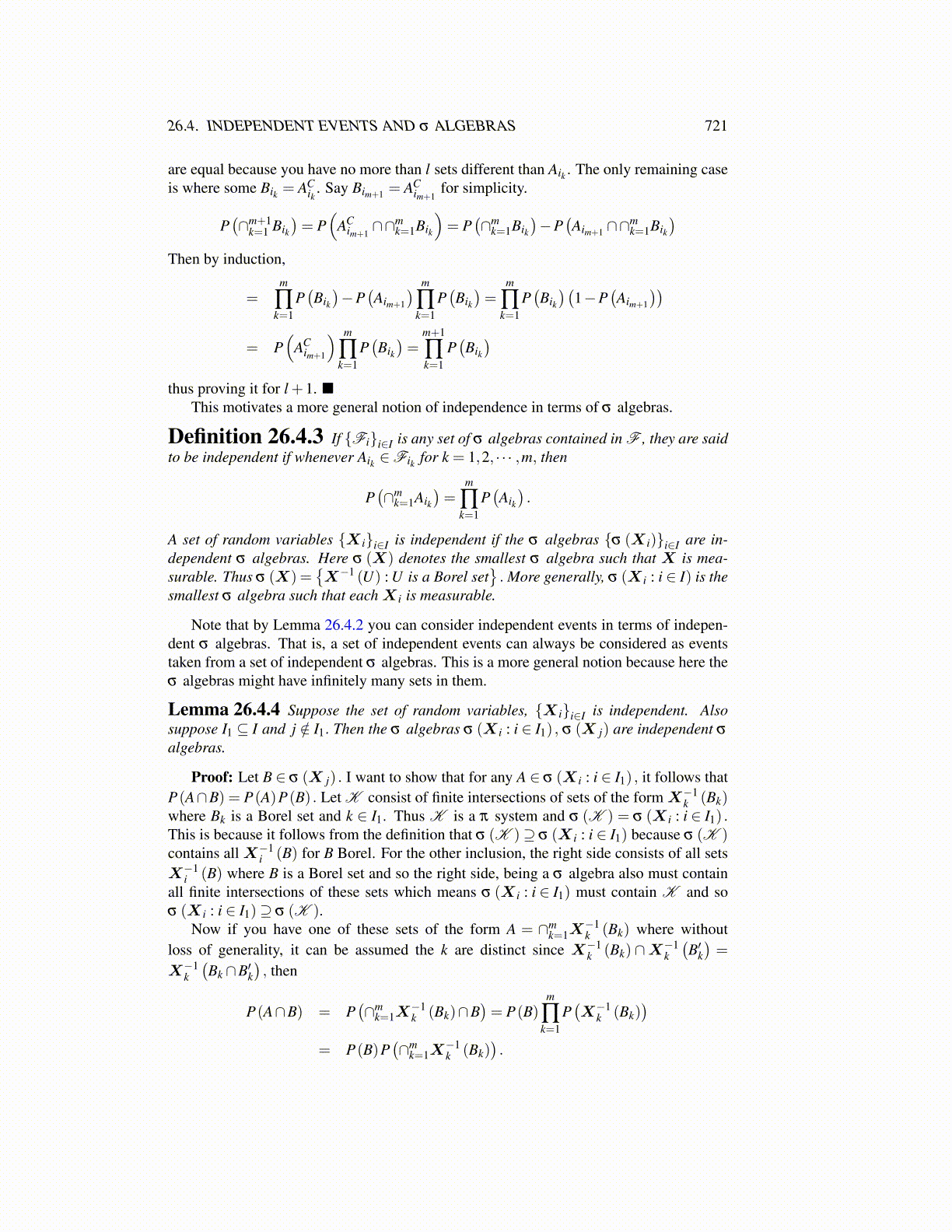
26.4. INDEPENDENT EVENTS AND σ ALGEBRAS 721
are equal because you have no more than l sets different than Aik . The only remaining caseis where some Bik = AC
ik. Say Bim+1 = AC
im+1for simplicity.
P(∩m+1
k=1 Bik
)= P
(AC
im+1∩∩m
k=1Bik
)= P
(∩m
k=1Bik
)−P
(Aim+1 ∩∩
mk=1Bik
)Then by induction,
=m
∏k=1
P(Bik
)−P
(Aim+1
) m
∏k=1
P(Bik
)=
m
∏k=1
P(Bik
)(1−P
(Aim+1
))= P
(AC
im+1
) m
∏k=1
P(Bik
)=
m+1
∏k=1
P(Bik
)thus proving it for l +1. ■
This motivates a more general notion of independence in terms of σ algebras.
Definition 26.4.3 If {Fi}i∈I is any set of σ algebras contained in F , they are saidto be independent if whenever Aik ∈Fik for k = 1,2, · · · ,m, then
P(∩m
k=1Aik
)=
m
∏k=1
P(Aik
).
A set of random variables {X i}i∈I is independent if the σ algebras {σ (X i)}i∈I are in-dependent σ algebras. Here σ (X) denotes the smallest σ algebra such that X is mea-surable. Thus σ (X) =
{X−1 (U) : U is a Borel set
}. More generally, σ (X i : i ∈ I) is the
smallest σ algebra such that eachX i is measurable.
Note that by Lemma 26.4.2 you can consider independent events in terms of indepen-dent σ algebras. That is, a set of independent events can always be considered as eventstaken from a set of independent σ algebras. This is a more general notion because here theσ algebras might have infinitely many sets in them.
Lemma 26.4.4 Suppose the set of random variables, {X i}i∈I is independent. Alsosuppose I1 ⊆ I and j /∈ I1. Then the σ algebras σ (X i : i ∈ I1) , σ (X j) are independent σ
algebras.
Proof: Let B ∈ σ (X j) . I want to show that for any A ∈ σ (X i : i ∈ I1) , it follows thatP(A∩B) = P(A)P(B) . Let K consist of finite intersections of sets of the formX−1
k (Bk)where Bk is a Borel set and k ∈ I1. Thus K is a π system and σ (K ) = σ (X i : i ∈ I1) .This is because it follows from the definition that σ (K )⊇ σ (X i : i ∈ I1) because σ (K )contains all X−1
i (B) for B Borel. For the other inclusion, the right side consists of all setsX−1
i (B) where B is a Borel set and so the right side, being a σ algebra also must containall finite intersections of these sets which means σ (X i : i ∈ I1) must contain K and soσ (X i : i ∈ I1)⊇ σ (K ).
Now if you have one of these sets of the form A = ∩mk=1X
−1k (Bk) where without
loss of generality, it can be assumed the k are distinct since X−1k (Bk) ∩X−1
k
(B′k)=
X−1k
(Bk ∩B′k
), then
P(A∩B) = P(∩m
k=1X−1k (Bk)∩B
)= P(B)
m
∏k=1
P(X−1
k (Bk))
= P(B)P(∩m
k=1X−1k (Bk)
).